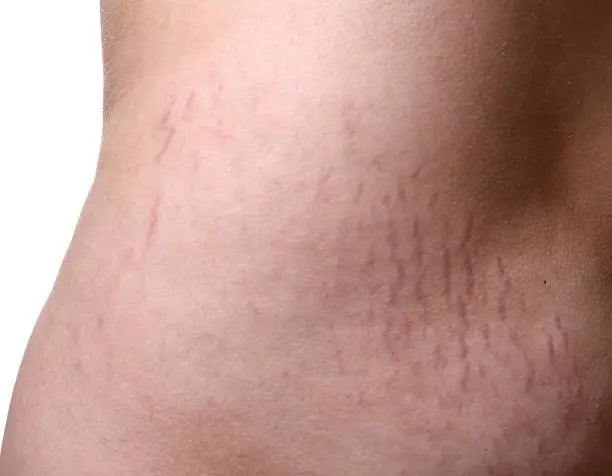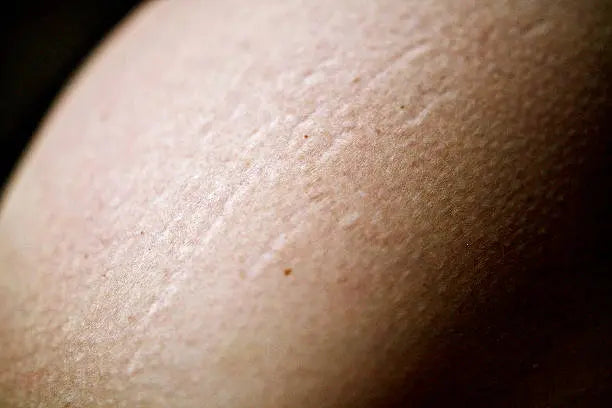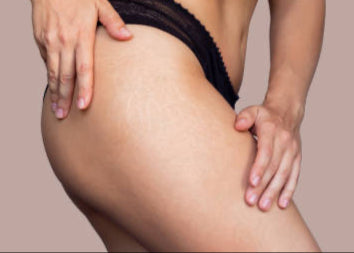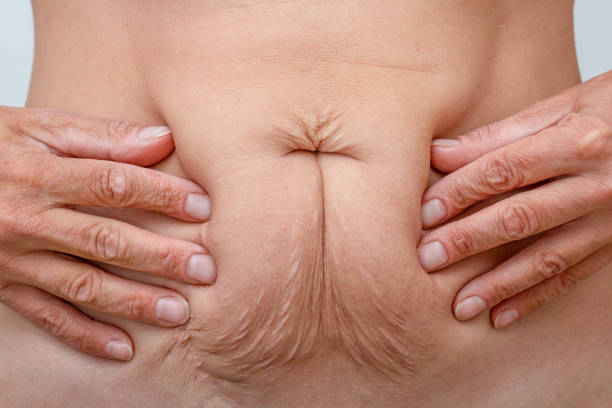
PRP Injections for Stretch Marks & Scarring
PRP for Stretch Marks & Scarring can create visible changes in skin texture and tone that don’t always respond to creams or topical treatments. They are a common result of factors such as growth, weight changes or skin stretching over time.
Share
PRP Injections for Stretch Marks & Scarring
Stretch marks and scars are common and can appear after changes such as growth, pregnancy, weight fluctuations or certain aesthetic procedures. They often leave visible lines or textural differences in the skin that many people wish to soften.
Platelet-Rich Plasma (PRP) is a non-surgical treatment that uses a small sample of your own blood to concentrate platelets. These platelets release natural growth factors which may support the skin’s repair processes. Some clients report that PRP helps their skin feel smoother, more even in tone, and more resilient over time.
Important to know:
-
Results vary, and no outcome can be guaranteed.
-
Common side effects include redness, swelling or mild bruising that typically settle within a few days.
-
PRP is not suitable for everyone; a consultation is required to assess medical history and skin condition.
-
Treatments are only available for adults aged 18+.


Who May Consider PRP for Stretch Marks & Scarring
This treatment may be suitable for adults (18+) who:
- Have visible stretch marks on areas such as the abdomen, thighs, hips, breasts, arms or buttocks
- Would like to soften the look of common scars or uneven skin texture
- Are interested in supporting overall skin tone and resilience in affected areas
- Prefer a natural approach that uses their own blood rather than synthetic products
- Wish to explore PRP alongside treatments like microneedling as part of a personalised skin programme
How PRP Works
PRP is prepared from a small sample of your own blood, which is processed to concentrate the platelets. These platelets contain natural growth factors that may help support your skin’s natural renewal response.
Some clients notice that PRP:
- Contributes to smoother-feeling skin in the treated area
- Helps refine texture or tone over time
- Leaves the skin feeling more resilient
PRP can be used alone or combined with microneedling, where the tiny channels created in the skin may allow PRP to be absorbed more effectively.
Important to know:
- Results vary and cannot be guaranteed.
- Possible side effects include redness, swelling or mild bruising at the injection site, usually settling within a few days.
- A consultation is required to confirm suitability.

Treatment Areas for PRP in Scarring and Stretch Marks
PRP can be considered for a range of common concerns, including:
- Stretch marks on the abdomen, hips, thighs, breasts, lower back and arms
- Areas of uneven skin texture such as acne-related marks
The approach used will depend on your skin type, the nature of the scarring, and your overall treatment plan. During your consultation, a registered practitioner will discuss whether PRP is appropriate for your goals and explain the safest way it can be applied.
What to expect from your procedure:
-

Treatment Duration:
45–60 minutes
-

Pain Level:
Mild to moderate; numbing cream may be used for comfort
-

Downtime:
Minimal—expect redness or swelling for 24–48 hours (longer if combined with microneedling)
-

Results Seen:
Early improvements in skin texture and colour within 4–6 weeks
Continued collagen remodelling over 8–12 weeks
Best outcomes seen with 3–6 sessions, depending on severity and skin response
-

Longevity:
Results are long-lasting, with annual maintenance advised for optimal skin health
Who May Be Suitable for PRP for Stretch Marks & Scars
PRP may be considered for adults (18+) who:
- Have visible stretch marks, whether recent or longstanding
- Would like to soften the look of acne-related marks or uneven skin texture
- Prefer a treatment using their own blood rather than synthetic injectables
- Have a range of skin tones or skin types, including sensitive skin
When PRP is not suitable:
- In areas with active infection
- On keloid scars
- For some underlying medical conditions (discussed during consultation)
Your practitioner will review your medical history, skin type and concerns to decide whether PRP is appropriate. In some cases, a combination with treatments such as microneedling or topical therapies may be recommended to support your goals.
Book your consultation today and experience the confidence-boosting benefits at Haus of Ästhetik.
Contact form
Protein Rich Plasma Procedures
-
RF Microneedling Epidermal strengthening, eye area rejuvenation
Vendor:HAUS OF ÄSTHETIKRegular price From £250.00 GBPRegular priceUnit price / per -
RF Microneedling Surface smoothing, crepey skin, texture refinement
Vendor:HAUS OF ÄSTHETIKRegular price From £300.00 GBPRegular priceUnit price / per -
RF Microneedling Full-face tightening, moderate ageing & scarring
Vendor:HAUS OF ÄSTHETIKRegular price From £350.00 GBPRegular priceUnit price / per -
RF Microneedling Precision tightening, deep scarring correction
Vendor:HAUS OF ÄSTHETIKRegular price From £350.00 GBPRegular priceUnit price / per
Frequently Asked Questions
What is PRP?
PRP stands for Platelet-Rich Plasma. It is a regenerative treatment that uses a concentrated form of your own blood, rich in platelets and growth factors, to stimulate healing, tissue repair, and collagen production in the targeted area.
How does PRP work?
A small sample of your blood is drawn and processed in a centrifuge to isolate the plasma and concentrate the platelets. This platelet-rich solution is then re-injected into the area being treated. The high concentration of growth factors helps to stimulate cellular repair, promote collagen synthesis, and encourage natural regeneration.
What areas can PRP treat?
PRP can be used across a wide range of concerns, including:
• Hair loss and thinning (scalp)
• Facial rejuvenation (improving tone, texture, and fine lines)
• Tear trough rejuvenation
• Acne scars and skin texture
• Stretch marks and general scarring
• Skin laxity in the neck and décolletage
• Post-procedure healing and skin strengthening
What are the benefits of PRP treatment?
• Stimulates collagen and elastin production
• Improves skin tone, texture, and hydration
• Reduces the appearance of fine lines and wrinkles
• Restores volume in delicate areas (e.g., under eyes)
• Encourages hair follicle growth and density
• Reduces inflammation and promotes tissue repair
• Uses your body’s own natural healing response—no synthetic substances
How should I prepare for a PRP treatment?
• Stay well hydrated in the 24–48 hours before your appointment
• Avoid alcohol and caffeine for 24 hours prior
• Refrain from taking anti-inflammatories (e.g., ibuprofen, aspirin) for 48 hours beforehand unless medically required
• Avoid blood-thinning supplements (vitamin E, fish oil) for 3–5 days prior
• Ensure your scalp or skin is clean and free from active infections or irritations
• Eat a light meal before your appointment to minimise risk of dizziness during the blood draw
What to Expect During Your Treatment?
Consultation
• Your specialist at Haus of Ästhetik will begin with a detailed consultation, assessing your concerns, medical history, and the condition of the treatment area.
• For facial or scalp treatments, the skin and underlying structure will be examined; for hair loss, scalp health and pattern of thinning will be reviewed.
• A personalised treatment plan will be created to suit your goals, anatomy, and the most appropriate method of delivery.
Treatment Process
• For PRP procedures, a small sample of your blood will be taken—similar to a routine blood test.
• The sample is placed into a centrifuge, which spins for around 5–10 minutes to isolate the platelet-rich plasma (PRP) from the rest of the blood components.
• During this brief delay, your clinician may apply numbing cream or prepare the treatment area.
• Once the PRP is ready, it is carefully injected into the targeted area using fine needles or a micro-cannula, depending on the indication (e.g. scalp, under eyes, facial skin, or scar tissue).
• The entire procedure typically takes 30–60 minutes, depending on the size of the area being treated.
Post-Treatment
• You may experience mild redness, swelling, or sensitivity at the injection sites. These effects are normal and usually subside within a few hours to a couple of days.
• Some pinpoint bruising may occur, especially in delicate areas such as the under eyes or scalp.
• You can return to most daily activities immediately, although specific aftercare advice will be provided for optimal healing.
• Results develop gradually, as PRP stimulates cellular repair and collagen production:
• Subtle improvement may be seen after the first session
• Most clients notice visible benefits after 2–3 sessions, with progressive improvements over 2–6 months depending on the area and concern
Your practitioner will advise on the recommended treatment schedule and whether maintenance or combination therapy is suitable to enhance and sustain your results.
How long does a PRP procedure take?
The full treatment takes approximately 30–60 minutes, depending on the area being treated. This includes the blood draw, centrifugation, and injections.
Is PRP treatment painful?
Most patients experience only mild discomfort. For skin or facial treatments, a topical anaesthetic can be applied. Scalp treatments may cause brief stinging or pressure. Discomfort is generally short-lived.
What is the downtime after PRP?
Downtime is typically minimal. You may experience:
• Mild swelling, redness, or bruising at the injection site
• A feeling of tightness or tenderness for 24–72 hours
• For scalp treatments: temporary scalp sensitivity or minor crusting
Most clients resume normal activities the same day or next day.
How many treatments will I need?
• Hair Loss: 3–4 sessions, spaced 4–6 weeks apart, followed by maintenance every 4–6 months
• Facial Rejuvenation / Scars: 3 sessions initially, then 1–2 annually
• Tear Trough / Eyes: Typically 2–3 sessions for visible improvement
• Scarring / Stretch Marks: 3–6 sessions, depending on severity and location
The number of sessions depends on your concerns, response, and treatment area.
When will I see results?
• Hair: Noticeable improvement after 2–3 sessions; full results typically visible in 3–6 months
• Skin / Face / Eyes: Initial glow or texture improvement within 1–2 weeks; collagen remodelling continues over 6–12 weeks
• Scars / Acne: Gradual improvement over 2–3 sessions, with ongoing skin renewal over several months
How long do PRP results last?
Results vary by treatment area and individual response, but typically:
• Hair regrowth lasts 6–12 months with maintenance
• Skin rejuvenation can last up to 12 months with good skincare
• Scar and texture improvements are long-lasting, though ongoing maintenance may be needed in cases of active skin conditions
Is PRP safe?
Yes. PRP is considered very safe because it uses your own blood, eliminating the risk of allergic reaction or disease transmission. All procedures are performed in a sterile, clinical environment by trained professionals.
Are there any risks or side effects?
PRP has a low risk profile. Possible side effects include:
• Mild swelling or bruising
• Temporary discomfort at injection sites
• Headache or tightness (more common in scalp treatments)
• Infection (rare, if post-care instructions are followed properly)
Can PRP be combined with other treatments?
Yes. PRP can enhance and support a range of treatments:
• Microneedling: Improves delivery and absorption of PRP in skin
• Polynucleotides: Can be alternated to maximise regeneration and skin quality
• Skin Boosters / Toxin: PRP complements hydration and firming treatments
• LED Therapy: May support healing and reduce inflammation post-procedure
Who is not suitable for PRP?
PRP may not be suitable if you:
• Are pregnant or breastfeeding
• Have blood disorders or platelet dysfunction
• Are undergoing chemotherapy or radiotherapy
• Have active skin infections or inflammation in the treatment area
• Have uncontrolled diabetes or autoimmune conditions (consultation required)
What are common myths about PRP?
“PRP is the same as filler”
– False. PRP stimulates collagen and healing; it does not add volume like filler.
“Results are instant”
– False. PRP works over time to regenerate tissue. Results develop gradually over weeks to months.
“Only celebrities use PRP”
– False. PRP is widely accessible and used in medical and aesthetic practices worldwide.
“It doesn’t work”
– Incorrect. Clinical studies support PRP’s effectiveness in hair regrowth, skin rejuvenation, and scar treatment when properly indicated and administered.
How do I maintain my PRP results?
• Follow your practitioner’s maintenance schedule
• Use quality medical-grade skincare or hair care products
• Protect skin from sun exposure
• Maintain a healthy diet and avoid smoking
• Consider combining PRP with other regenerative or supportive treatments
Why Choose Haus of Ästhetik?
At Haus of Ästhetik, we prioritise expertise, precision, and client satisfaction. Our treatments are carried out by highly trained practitioners, ensuring natural-looking results with a safety-first approach. We provide bespoke, medically led treatments tailored to your individual goals, so you can feel confident in the results.







